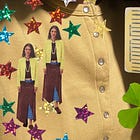So You Want To Be a Medieval Sex Symbol
The hottest accessory of 1367 is coming to a waist near you
My friend A doesn’t carry a purse. On any given evening, you might spot her Citibiking between boroughs with a single AirPod balancing in one ear, a loose house key tucked in the band of her bra, and her phone gripping the inside of her waistband in terror.
She forgoes any sort of bag altogether, even when an outfit doesn’t have pockets. Recently she met me for dinner in a baby tee and a cotton mini skirt, nothing close to a pocket in sight, and I had to beg her to let me carry the loose AirPods in my own bag. Sends shivers down my spine to even think about it.
She used to own one purse (a practical work bag, nothing flashy), but after it broke recently she’s resorted to a “ratty” Reformation tote for taking to the office. Otherwise, she’s flying free and purse-less, completely unburdened.
I can’t pretend that I’m brave enough to do the same — she lives on the edge of something most of us wouldn’t dare stand 10 feet from. But I do feel a notable sense of freedom on the rare occasions I find myself sans purse.
Like a walk around the block with my partner (where I force him to carry the keys and a phone) or on the dance floor of a wedding (where I haven’t seen my tiny purse in an hour, probably sitting on a folding ballroom chair). It’s the freedom that keeps A bagless.
This conversation sent me down a familiar rabbit hole: medieval purses. I was thinking I could pitch her a belt bag and save her from this purseless prison, so I pulled Hannah Carlson’s Pockets: An Intimate History of How We Keep Things Close off my bookshelf.
Before pockets, there were purses, we learn in just chapter 1, and generally these were drawstring pouches or bags with flap openings attached at the waist. Belt bags of medieval times were the original hands-free carrying option, and beyond their practicality lies a sultry history…
A medieval “what’s in my bag?” might not look all that different than the 2025 version.
Purses in the middle ages carried everyday items like mirrors, cosmetic sets, combs, paternosters, wooden spoons, tiny mallets, dice, thimble rings, and small knives, and well as valuables like coins, rings, personal seals, and pocket sundials1.

I too keep cosmetics in my purse (2-5 lip products at all times), loose change, various pieces of jewelry I might have taken off midday, a pen or two, and a tattered deck of cards. How do you think a 14th century nun would handle a round of Monopoly Deal?
And like our purses today, they were made of cloth, silk, velvet, and all types of leathers; deerskin, calfskin, sheepskin, and goatskin2. The levels of luxury varied wildly, too, (think Uniqlo nylon crossbody vs. Loewe puzzle bag) and were also worn to signal social status3.
Peasants and shepherds wore purses in their day-to-day laboring4 while Henry V sported a pouch-belt made with gold valued at £65 — about the salary of a skilled tradesman for 300 days work in 1420 or, adjusted in today’s currency, nearly £4,000. (In 2025, Henry V would have his Hermes sales associate on call.)

Purses were functional, luxurious, and, at times, deeply and strangely sexy. A bag that swung around was desirable, actually… erotic even!
As instructed in one 1200 “popular medieval handbook” written by the “God of Love,” Carlson explains, it’s crucial to dress nicely in order to garner the attention of a lover. You might want to “deck yourself out” with a “silk purse,” he advises.6
The purse’s placement around the pelvic area, often hanging between the legs, “had enormous erotic appeal,” Carlson says, citing the work of medieval poet Geoffrey Chaucer7.

Chaucer comes up repeatedly in research regarding medieval sexuality and dress — he was nothing if not interested in the saucier side of life. I reached out to a medievalist friend of mine (highly recommend having one in your Rolodex) and asked about Chaucer’s The Canterbury Tales, in which Chaucer details the sensual outfit of a captivating young woman named Alison.

While fashion isn’t my friend’s subspecialty (it’s religion), he described Alison and her generously-portrayed girdle as “unforgettable.” Some of the more raunchy medieval poems make references to purses to evoke the scrotum, he added.
Chaucer uses Alison’s girdle, and the purse that dangles from it, to take the listener on a journey up and down her body, writes Gale R. Owen-Crocker. And in the case of a male suitor, a knife dangling from a belt or bag could be meant “to draw attention to those parts of the male anatomy which had conventionally been concealed by clothing.”8
Today’s belt bags evoke images of dorky Disneyland dads and ‘90s moms passing out orange slices at Little League, decidedly pretty unsexy scenarios. But even our American name for the bag, fanny pack, carries an erotic weight to it given the meaning of “fanny” outside the States.
Ultimately, a hands-free bag offers freedom, and there is an inherent sex appeal in that freedom. A city summer, air thick with humidity and pheromones, feels free in part due to the lack of clothing required to stay comfortable.
Hefty clothing and accessories weigh on not only our shoulders but also our desires. It’s hard to feel frisky in a down parka.
Some of the warm season’s best pieces hardly count as clothing at all — swimsuits as dinner wear, completely see-through skirts and dresses, a tan midriff that screams “I haven’t been hidden under a full-length t-shirt in months!”
In skimpy summer attire — weightless, free-falling into the 9pm sunset, skin melting into warm air, floating through the night untethered from reality — a slippery purse strap is a hazardous earthly burden. Break free from the confines of shoulder bags, and say yes to a hands-free lifestyle with a sexy fanny pack. You’re only a millennium behind on the trend…
As for A?
She’s on a journey to sew her own. In the meantime, I might just buy her a bag myself to save those poor AirPods from the gutter.
if you’re itching for your own…
Belt bags for sexpots. Vintage and secondhand belt bags so you TOO can be as unburdened in life as A and as in touch with your sexuality as Alison and her girdle.
All proceeds from paid subscriptions in August (both recurring monthly payments + upgrades made this month) will be donated to mutual aid in Gaza. I’ll be donating directly to Stephanie H. Shih who has been distributing resources in Gaza for the last year and a half. You can learn more about Stephanie’s work here.
Check out these vintage picks too!
The best of cotton, silk, and linen vintage GAP.
Silver swirls are calling to you from the sea…
Enough shorts to last a lifetime.
“Clothing the Body: Age, Sexuality and Transitional Rites” in Medieval Life: Archaeology and the Life Course (pages 68-113) by Roberta Gilchrist.
Dress Accessories: Medieval Finds from Excavations in London (pages 342–57) by Geoff Egan and Frances Pritchard.
“Clothing the Body: Age, Sexuality and Transitional Rites” in Medieval Life: Archaeology and the Life Course (pages 68-113) by Roberta Gilchrist.
Dress in the Middle Ages (page 48) by Françoise Piponnier and Perrine Mane.
“Pouches post-1100” in Encyclopedia of Medieval Dress and Textiles Online by Maria Hayward.
Pockets: An Intimate History of How We Keep Things Close (page 14) by Hannah Carlson.
Pockets: An Intimate History of How We Keep Things Close (page 15) by Hannah Carlson.
“Sensuality and sexuality” in Encyclopedia of Medieval Dress and Textiles Online by Gale R. Owen-Crocker.












Fusing my two favorite things- history and fashion! Loved this piece!!
obsessed with the medieval what’s in my bag!! 🏰